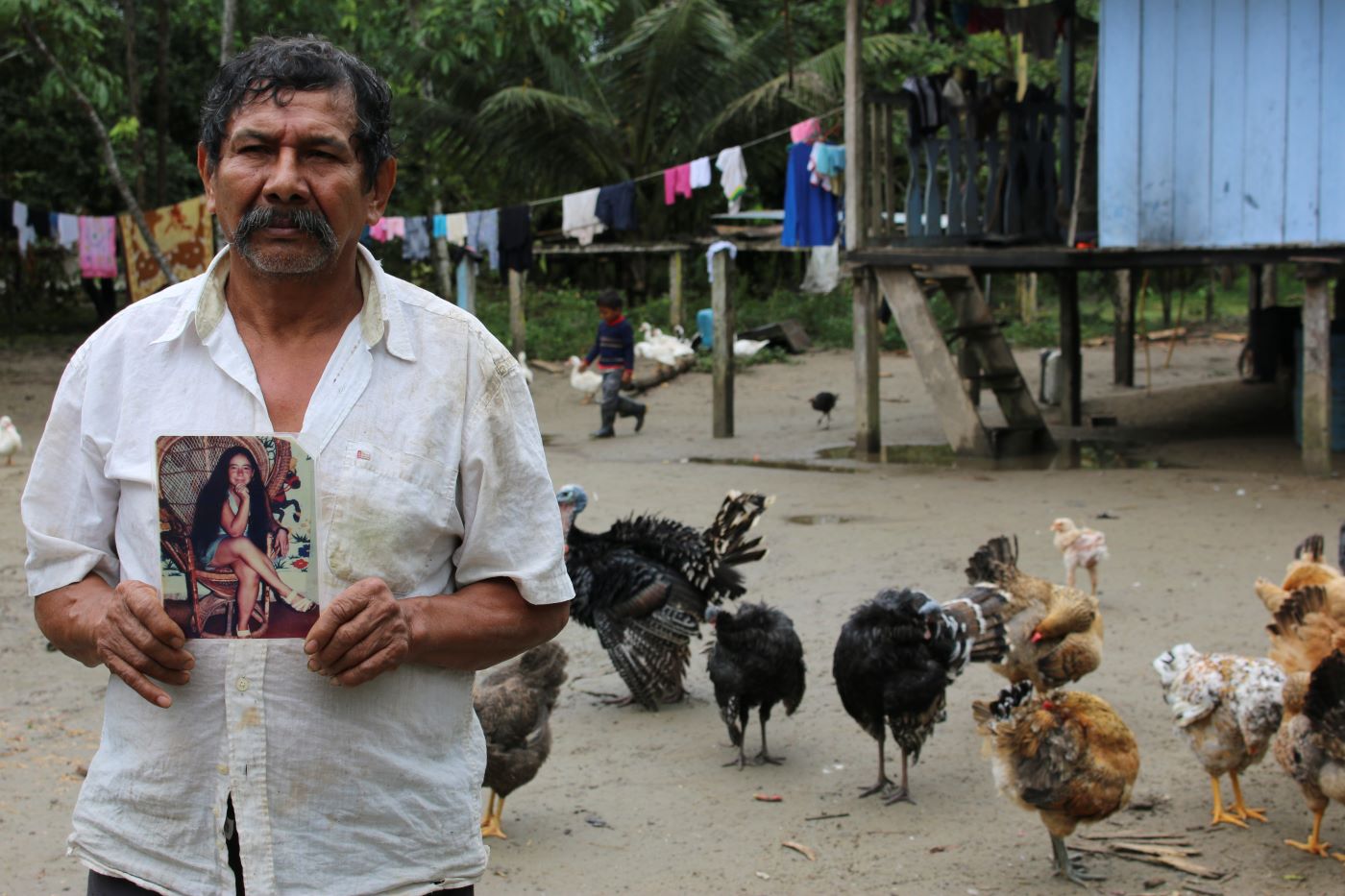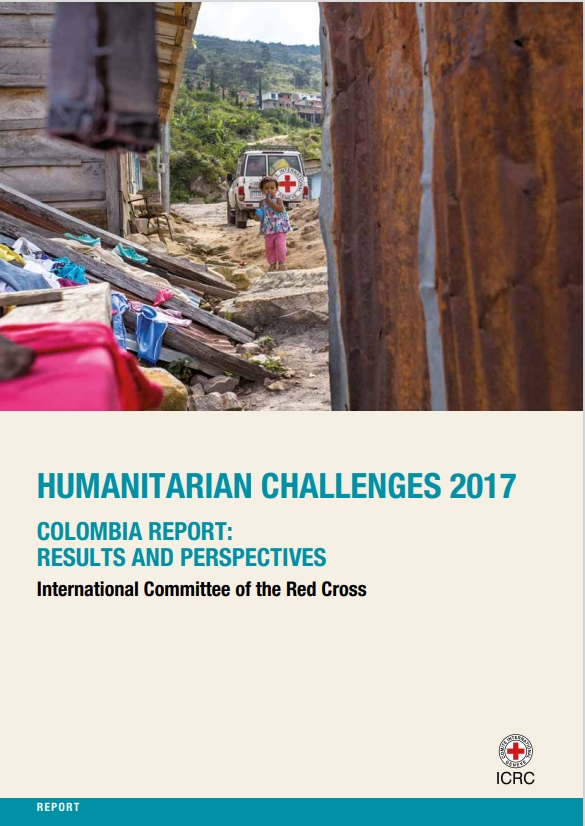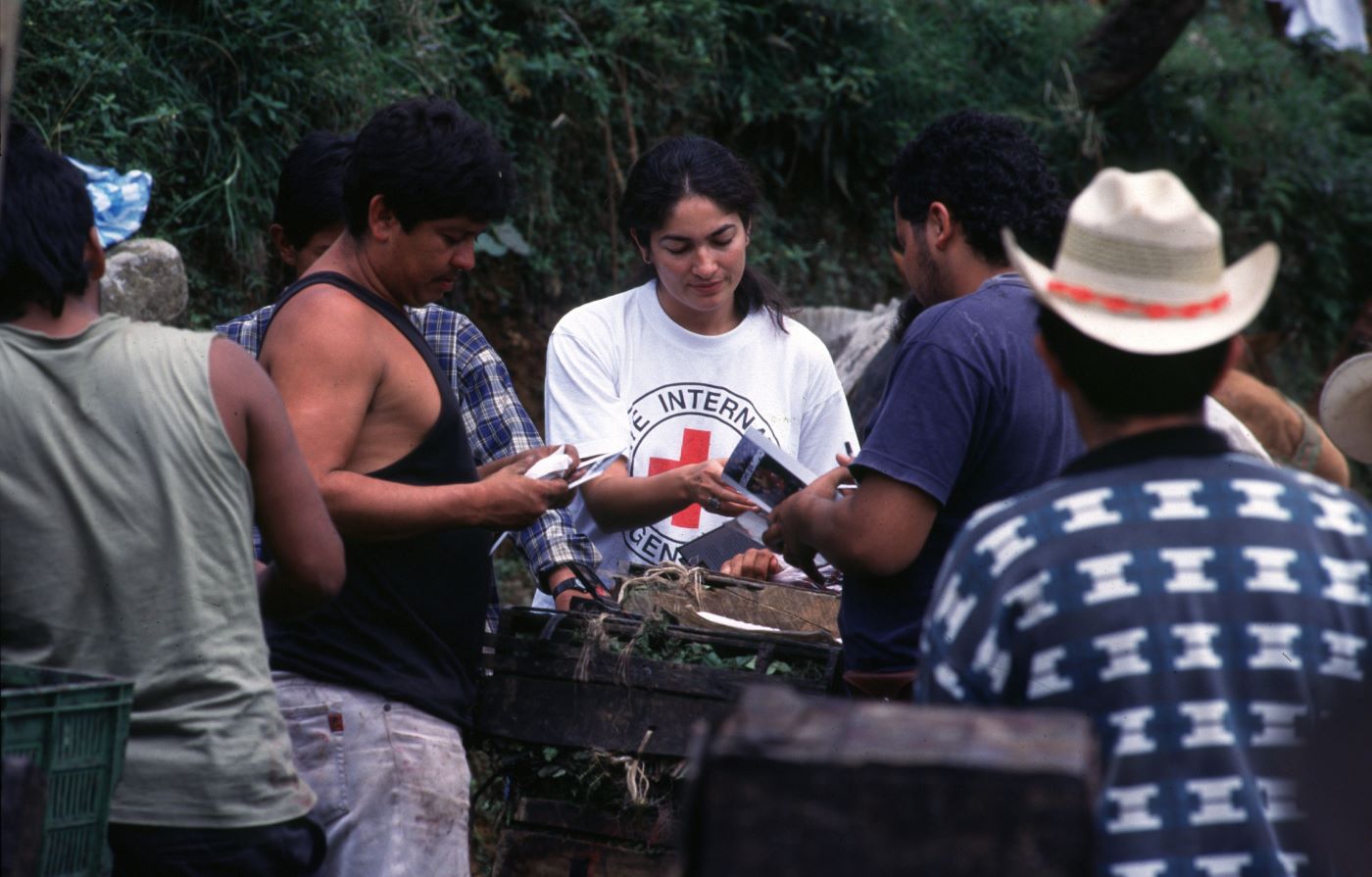“An extraordinary 72% of Colombians say the ICRC/Red Cross has played the biggest role in preventing mistreatment and abuses during the armed conflict.” From the 1999 “People on War” survey in Colombia, part of an ICRC worldwide consultation on the Rules of War.
Table of Contents
Introduction – Overview – 1970s-80s – 1990s – Deprivation of liberty in NIACs – 2000s – Dissemination of resources – 2010s – Further sources
The non-international armed conflicts between the government of Colombia and non-state armed groups are considered to have begun in 1964, as a result of political and organized violence affecting several regions of the country in the 20th century.[1] One of the longest crises in modern history, it has claimed countless lives, displaced millions of people, and disproportionally affected Indigenous and Afro-Colombian peoples.[2]
In the 1960s, continued violence and repression in rural areas led to the formation of several non-state armed groups, such as the Revolutionary Armed Forces of Colombia (FARC-EP) and the ELN (National Liberation Army). Following escalations, the ICRC set up its operations for the first time in the country in 1969. At the beginning, the ICRC did not have a permanent presence in the country, and only counted on a mobile delegate from the delegation in Venezuela for visits to detention facilities. Later, in 1980, the ICRC officially established its offices in Bogotá.
Over the past 55 years in Colombia, the ICRC has developed extensive dissemination and development of the law trainings in international humanitarian law (IHL), including through direct dialogue with non-state armed groups. It implements programs to assist people affected by the armed conflict, such as people deprived of their liberty and displaced persons. It distributes basic necessities, restores family links, and provides medical and psychological care. As a neutral intermediary, the ICRC has facilitated the release of persons deprived of their liberty and encouraged the realization of special agreements and peace negotiations between parties to the conflict.
As of 2024, the ICRC delegation in Colombia is also covering dialogue over alleged violations to IHL with parties to NIACs, search of the missing including forensic action, care for the wounded and sick, prevention of weapons contamination, among others.
Throughout the years, the ICRC has developed a trust-based relationship with Colombian authorities, and sustains high-quality dialogue with them to strengthen the protection of victims of armed conflicts through the implementation of laws and regulations, and through capacity-building activities. For decades, ICRC operations in Colombia remained the organization’s largest in the Americas, with its headquarters in Bogotá and, as of 2024, 12 other offices across the country.
Conceived as an entry point to the ICRC’s Library and Archives’ rich collections, this page aims to provide an overview as comprehensive as possible of the main public documentary resources available on the activities of the ICRC during the non-international armed conflicts (NIACs) in Colombia.[3]
Overview – ICRC action and IHL during the NIACs in Colombia
Given Colombia’s experience with overlapping non-international armed conflicts and situations of violence, determining the applicable legal framework has often been challenging and occasionally led to misinterpretation. The main IHL provisions relevant to Colombia’s NIACs are Common Article 3 of the Geneva Conventions, the Additional Protocol to the Geneva Conventions II (AP II), and Customary IHL applicable to NIACs.[4]
Colombia participated in the 1977 International Diplomatic Conference that adopted Additional Protocols I and II, but the ratification of these instruments was then delayed due to political concerns (API was ratified in 1993 and APII in 1995).
- Colombian cases in the “IHL in action” database: examples of demobilization of child recruits, mine action, and providing answers to the families of the missing in Colombia.
- ICRC online casebook on Colombia.
- Publications by the ICRC delegation in Bogota.
- International Humanitarian Law in Colombia: Going a Step Beyond, Marcela Giraldo Muñoz and Jose Serralvo (2019).
- The ICRC as a humanitarian mediator in the Colombian conflict: Possibilities and limits, Thomas Jenatsch (ICRC delegate on assignment in Colombia at the time of writing this article, 1998).
Secondary literature
- The International Committee of the Red Cross and support for civilian self-protection in Colombia, Oliver Kaplan (2021).
- Providing relief in times of war : the role of the ICRC in the Colombian conflict during the Uribe administration (2002-2010), Sandra Borda (2015).
- The Role of the International Committee of the Red Cross in the Implementation and Development of International Humanitarian Law in Colombia (in Spanish), Mónica Vanessa Angarita López, (2022)
During the 1970s and 1980s, the emergence of various non-state armed groups, such as the AUC (United Self-Defense Forces of Colombia) and the M-19 (Movimiento 19 de Abril), intensified the conflict. This made humanitarian needs more challenging to address. The ICRC installed its regional delegation for the Andean countries, Guyana, and Suriname in Bogotá, through an agreement with the Colombian Government in May 1980.[5]
In the 1990s, the conflict took a heavy toll on the civilian population, many were kidnapped by armed groups, mostly for political leverage or to urge the government to release prisoners associated with such groups.
The violence mounted, but ICRC’s presence in the field became better known and accepted. For example, affected populations were more confident in ICRC’s intermediary role for transmitting allegations of violations of humanitarian law to the respective parties.[6] More field offices opened, and the delegation’s staff almost doubled in 1996 and 1997.
In 1997, ICRC’s operation in Colombia was not only its largest in the Americas, but also the one involving the broadest spectrum of activities under its mandate. From that year, it continued to increase its presence, until it reached a total of 16 sub-delegations and offices in 1999.
In 1999, Colombian prisons housed about 48,000 detainees in overcrowded and deteriorating conditions. Frequent riots and acts of violence among detainees often led to fatalities. The ICRC closely monitored the situation and submitted reports to detention authorities. Additionally, the ICRC provided financial support to the prison health services for the purchase of medicines and medical equipment and helped finance medical and surgical treatment for detainees.[7]
A peace process also began in 1999 between the Colombian government and the FARC-EP. A demilitarized zone was established to carry out peace talks between the parties to the conflict. After years of stalled talks and ongoing violence, the process was unsuccessful, which resulted in more military pressure on the FARC-EP and other groups.
ICRC’s aid at the time was channeled through formal programs such as “Quick Impact Projects”, implemented in coordination with public agencies and other organizations, designed to help the displaced and returnees during the critical transition period between relief, rehabilitation, and community integration. The projects focused on the restoration of small-scale infrastructure and on income-generating projects in the agricultural and fisheries sector.[8]
Deprivation of liberty in NIACs
At the height of the conflict in Colombia, many people were deprived of their liberty by parties to the conflict. IHL provides specific protection for people deprived of their liberty, especially Common Article 3 in the case of NIACs. Find different types of deprivation of liberty here, an ICRC publication on the topic, and related international law here.
The ICRC, as neutral intermediary, has facilitated the release of 1,960 people deprived of their liberty by the end of 2023. ICRC action can be based only on humanitarian considerations, and it cannot intervene in negotiations relating to the conditions for release.
Overview and some examples throughout the years:
- ICRC webpage: Return to freedom: 44 years of neutral intermediation in Colombia
- 1997: 70 soldiers from the government army taken prisoner by the guerrillas were released and handed over to the ICRC. As seen in the ICRC Audiovisual Archives.
- 1980: An armed group occupied the Dominican Embassy in Bogotà, and held captive the 53 people assembled there. The ICRC was officially requested by the Colombian Government to visit them, and then managed to facilitate their release.
- 1999 : release of 33 persons abducted by the ELN
- 2008: misuse of the emblem in the release of people deprived of their liberty by the Colombian armed forces and a testimony of liberation through the help of the ICRC.
Academic literature
- “Prisoners of war, taking of hostages and the Colombian armed conflict: challenges arising out of conflictive understandings of IHL by different actors in particular contexts” / Juana Inés Acosta-López and Ana Idárraga (2021)
- “Hostage-Taking and Other Serious Deprivations of Liberty: Advances and Pending Challenges of the Case 001 in the Special Jurisdiction for Peace in Light if International Law” (Article in Spanish)
In the early 2000s, the ICRC remained the only humanitarian organization in Colombia that managed to maintain contact with the leadership of all parties to the conflict. Steps forward were taken as the government and the AUC signed an agreement for peace negotiations in 2003, which disarmed and demobilized thousands by 2006.
With a renewal of confrontations and the humanitarian situation deteriorating, the ICRC had to reorient its operations to address “priority zones”, where needs were greatest.[9] Displacement was a central focus of these efforts, as Colombia had the world’s largest internally displaced population (IDPs). In 2005, the ICRC published a joint report with the World Food Programme to identify the specific issues IDPs faced. Two years later, they carried out an additional analysis on the local institutional response, living conditions and recommendations for the care of the displaced population in different cities.
In 2007, the number of casualties from mines and explosive remnants of war (ERW) was among the highest in the world. The ICRC contributed to addressing weapon contamination for years to come.

San José del Guaviare. The members of the community are reading the ICRC leaflet “Assistance to mine victims and other explosive engines”. 2010 ©ICRC
Colombia has ratified key international humanitarian law treaties. The following documents have supported, or result from, ICRC efforts to disseminate IHL and related instruments to the government, the non-state armed groups and the public in Colombia:
- The Red Cross and my country : teacher’s manual, 1970
- Creation of an Inter-American Institute of International Humanitarian Law, 1976
- Armed Conflict and Humanitarian Law: Proceedings of the Seminar/Workshop Held in Bogotá,1994
- Disseminating international humanitarian law in Colombia. Dissemination is everyone’s job — a firsthand report by an ICRC delegate, Roland Bigler (1997).
- Product of the seminar “International Humanitarian Law and Armed Conflict in Colombia”, 1996: Humanizar la guerra : una opcion urgente
- ICRC Study of Customary International Humanitarian Law: Proceedings of the Presentation Event, 2008
- Anuario iberoamericano sobre derecho internacional humanitario 1,2,3,4 (2020-2023)
After more than 40 years of operational presence and IHL dissemination in the country, the ICRC noticed Colombians’ awareness of IHL was among the highest in the world.[10]
In 2012, concrete peace talks begun in Cuba between the government and FARC-EP. The ICRC facilitated the negotiation and operationalization of special agreements on the liberation of recruited children, weapon contamination and the search of missing persons, under Common Article 3 to the Geneva Conventions.
Before the signature of the final peace agreement in December 2016, the government and the FARC-EP committed to provide the ICRC with the information they possess about persons deemed as missing, for their search, location, identification, and respectable delivery of their remains.[11]
Moreover, the ICRC also actively participated as neutral intermediary providing technical humanitarian and IHL advice. In this context, the ICRC facilitated the transportation of armed groups’ members and 119 child soldiers.[12]

Rural area of Caquetá. This man and his wife have been looking for their daughter for 18 years. 2018 ©ICRC
From the beginning of peace negotiations, the ICRC assisted with the implementation of agreements and recommended not to delay mitigating humanitarian consequences of the conflict.[13]
The ICRC’s operations in Colombia at the time still represented the organization’s largest in the Americas, as the situation remained precarious, involving other armed groups, including the new non-state armed group derived from the fragmentation of the FARC-EP after the peace agreement, that is not party to it. In 2024, the humanitarian situation in the country continues to deteriorate, leading to severe consequences in certain rural and urban areas.
- As general reports on the activities of the International Committee of the Red Cross, these volumes include information on ICRC activities in Colombia during the conflict.
- Our IHL resources on Colombia
- For public statements by the ICRC concerning its action in Colombia, the digitized ICRC news releases are all available for consultation online.
- Resources about Colombia and about the ICRC in Colombia available in the ICRC Library’s online catalogue
- Colombia in the ICRC Audiovisual Archives
- Covid-19 in Colombia
- Article for the 50th anniversary of the ICRC delegation in Colombia
- “Colombia’s path towards peace: the role of IHL” event recording (2024)
General public archives references (mostly available in French and Spanish):
- B AG 225 050 Political Detainees and Security Detainees (Generalities, Correspondence Concerning Political Detainees, Reports of Visits to Detention Sites and Letters to Authorities, Correspondence with the Colombian Red Cross)
- B AG 252 060 Dissemination of IHL materials
Based on its access rules, the ICRC general archives are open for public consultation only up to 1975.
External resources
- Agencia Prensa Rural. “Las FARC Solicitaron al CICR Dar Trámite Formal para el Reconocimiento del ‘Acuerdo General’ entre Gobierno y Guerrilla como Acuerdo Especial.” Prensa Rural, 1 Dec. 2012, https://prensarural.org/spip/spip.php?article9746
- Joint Communiqué #62. Havana, October 17, 2015. Peace Agreements, https://www.peaceagreements.org/viewmasterdocument/1368
References
[1] Comisión de la Verdad. Hay futuro si hay verdad: Informe final de la Comisión de la Verdad. Comisión para el Esclarecimiento de la Verdad, la Convivencia y la No Repetición. 2022. https://www.comisiondelaverdad.co/informe-final
[2] Comité Internacional de la Cruz Roja y Programa Mundial de Alimentos. Identificación de las Necesidades Alimentarias y No Alimentarias de los Desplazados Internos: Una Encuesta Conjunta de las Poblaciones Desplazadas en Colombia. CICR, Mar. 2005. https://library.icrc.org/library/search/notice?noticeNr=59215 ; Annual Report 2004. International Committee of the Red Cross, 2004, p.239 https://library.icrc.org/library/search/notice?noticeNr=30124 ; Rueda, J. D., & Vargas, L. F. El desplazamiento interno en Colombia: Una mirada desde la perspectiva del Comité Internacional de la Cruz Roja. International Review of the Red Cross. 2001. https://international-review.icrc.org/sites/default/files/5-_el_desplazamiento_interno_en_colombia.pdf
[3] Most publications presented here are available for consultation at the ICRC Library and in its online catalogue. Archival sources from 1863 to 1975 can be consulted upon appointment at the institution’s headquarters in Geneva; see the service’s page for more information. For any question concerning the ICRC General Public Archives (their content, working procedures, the reading room, etc.), please write to publicarchives@icrc.org. Questions and suggestions on how to improve this page can be sent at library@icrc.org.
[4] More on customary IHL and NIACs: Henckaerts, J.-M., & Doswald-Beck, L. (Eds.). Customary International Humanitarian Law. Cambridge University Press. 2005. https://library.icrc.org/library/docs/DOC/icrc-1105-002-01.pdf ; Colombia customary IHL on the ICRC IHL database https://ihl-databases.icrc.org/en/customary-ihl/v2/by-country/co ; Non-international armed conflict on the ICRC online casebook https://casebook.icrc.org/law/non-international-armed-conflict#footnote5_daz8848 ; Customary IHL on the ICRC online casebook https://casebook.icrc.org/case-study/icrc-customary-international-humanitarian-law
[5] International Committee of the Red Cross. “Neutrality, Impartiality and Independence in Colombia: An ICRC Perspective.” Humanitarian Practice Network, 22 July 2021. https://library.icrc.org/library/search/notice?noticeNr=25286
[6] ICRC Annual Report 1993. p.193. https://library.icrc.org/library/search/notice?noticeNr=30146
[7] ICRC Annual Report 1999. p. 210. https://library.icrc.org/library/search/notice?noticeNr=30134
[8] ICRC Annual Report 2000. p. 135. https://library.icrc.org/library/search/notice?noticeNr=30165
[9] ICRC Annual Report 2004. https://library.icrc.org/library/search/notice?noticeNr=30124
[10] ICRC Annual Report 1996. p. 110. https://library.icrc.org/library/search/notice?noticeNr=30139
[11] Joint Communiqué #62. Havana, October 17, 2015. Peace Agreements, https://www.peaceagreements.org/viewmasterdocument/1368
[12] More on the special agreements and peace negotiations: Comité Internacional de la Cruz Roja (CICR). El CICR hace un llamado a la adopción de acuerdos especiales en el marco de las negociaciones. ICRC, 2024. https://www.icrc.org/es/document/el-cicr-hace-un-llamado-la-adopcion-de-acuerdos-especiales-en-el-marco-de-las-negociaciones. ; Comité Internacional de la Cruz Roja (CICR). Acuerdo de paz con las FARC: Es una nueva etapa para Colombia. ICRC, 2024. https://www.icrc.org/es/document/acuerdo-de-paz-con-farc-es-nueva-etapa-para-colombia. ; Comité Internacional de la Cruz Roja (CICR). Colombia: 10 preguntas sobre acuerdos de paz, acuerdos especiales y DIH. ICRC, 2016. https://www.icrc.org/es/document/colombia-10-preguntas-sobre-acuerdos-de-paz-acuerdos-especiales-y-dih.; Comité Internacional de la Cruz Roja (CICR). Acuerdos especiales y acuerdos de paz en el DIH: Comentarios sobre los Convenios de Ginebra en el contexto de Colombia. ICRC, 2016. https://www.icrc.org/es/document/acuerdos-especiales-acuerdos-de-paz-dih-colombia-comentarios-convenios-de-ginebra.
[13] International Committee of the Red Cross. Retos Humanitarios 2017: Informe Colombia: Resultados y Perspectivas. Edited by Isabel Ortigosa et al., Bogotá: CICR, March 2017. https://library.icrc.org/library/search/notice?noticeNr=44939












Comments